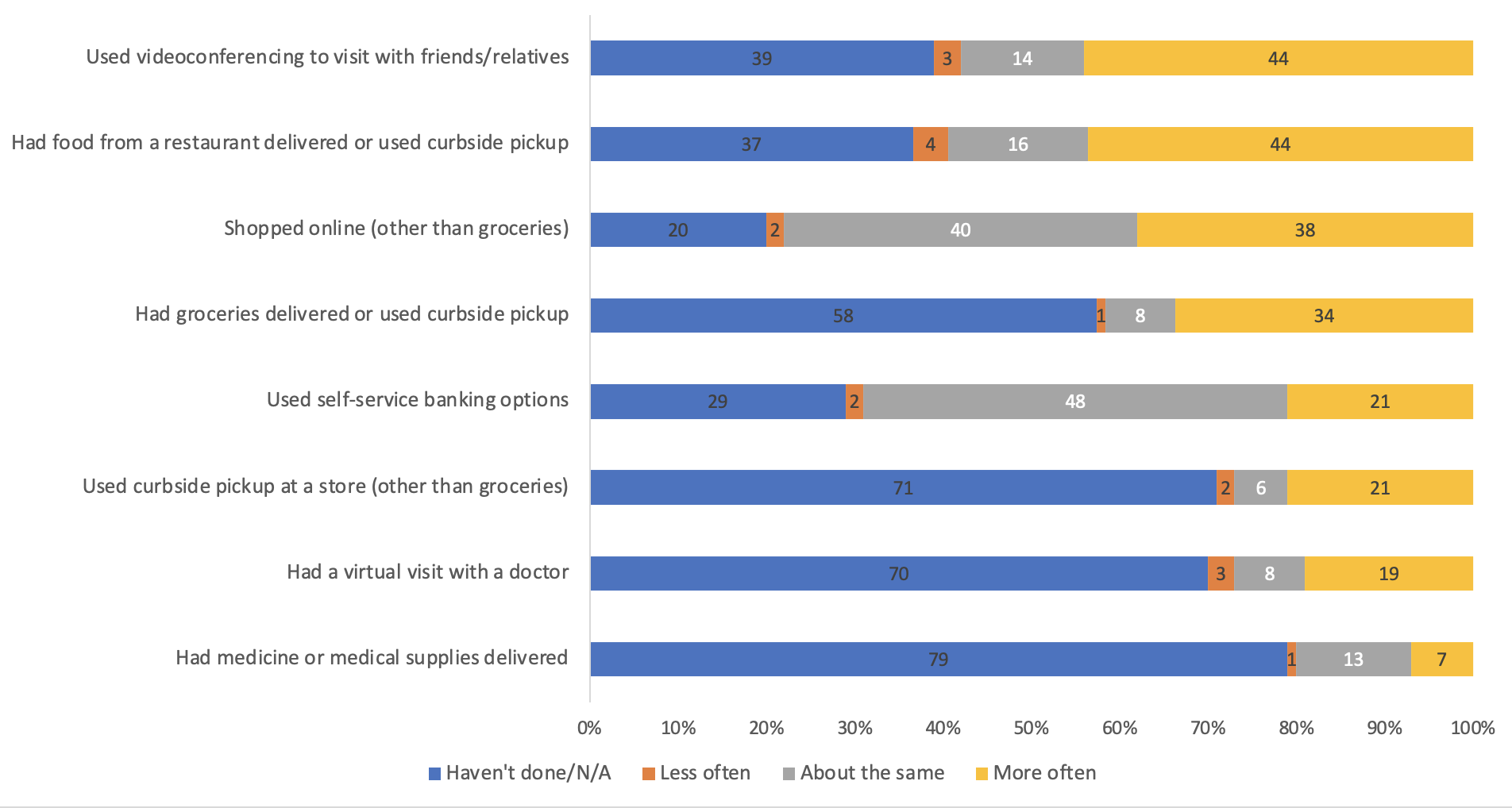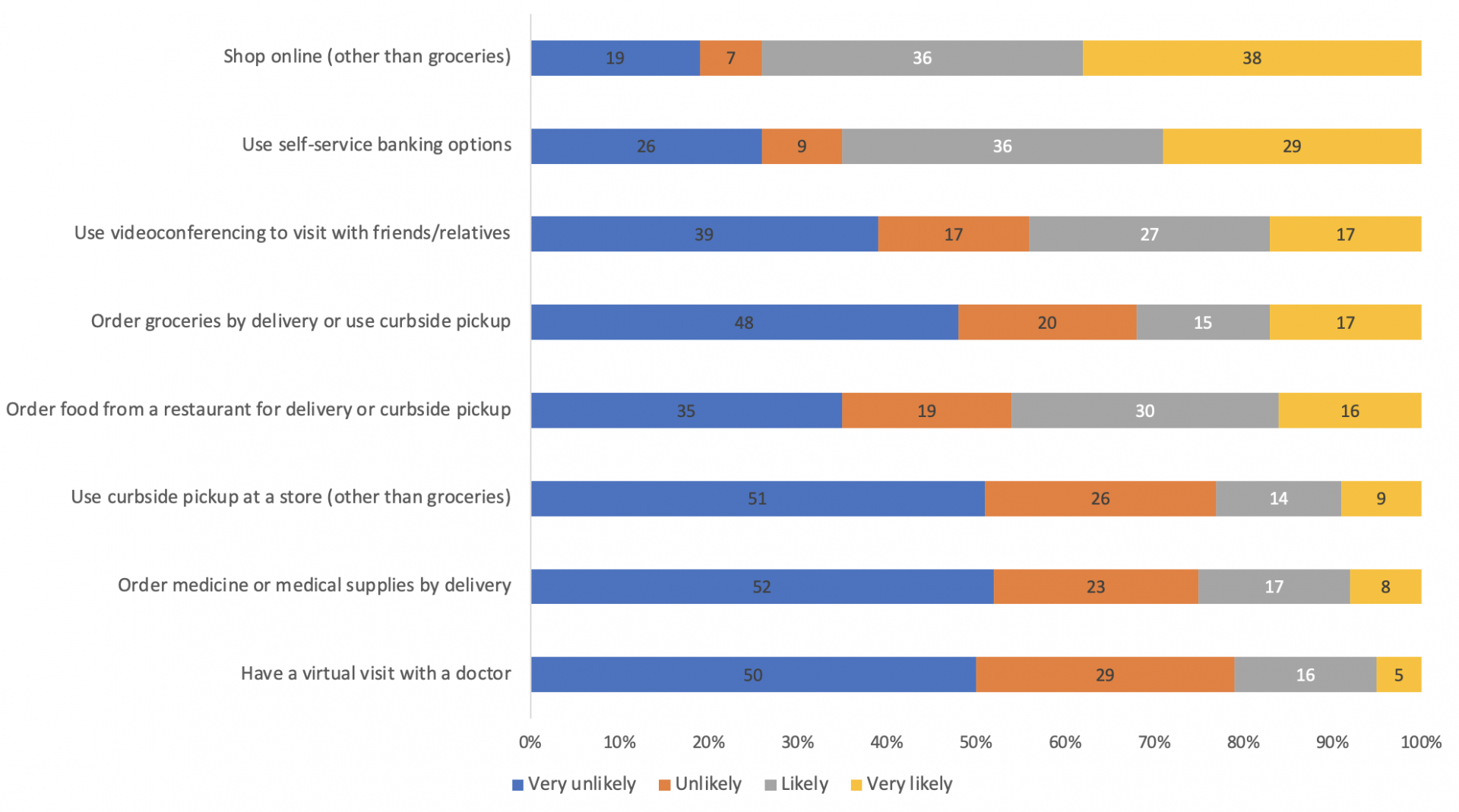USDA/Flickr (Public Domain)
The pandemic has impacted Nebraskans in many ways, including their consumer habits. As businesses shifted to new methods of operation and residents changed their behaviors, it is natural to assume that shopping patterns would be impacted. Given that, how did rural Nebraskans change their consumer habits during the pandemic, and will they continue these changes going forward? This can have important implications for businesses in rural communities as they adjust to meet these new demands.
The 2021 Poll looked at various impacts rural Nebraskans have experienced from the pandemic. Respondents were asked about ways they may have changed various consumer habits during the pandemic. They were asked if they engaged in various activities during the pandemic more often, less often or about the same as they did prior to it. Many rural Nebraskans engaged in the following activities more often during the pandemic: had food from a restaurant delivered or used curbside pickup (44%), used videoconferencing to visit with friends or relatives (44%), shopped online (other than groceries) (38%), and had groceries delivered or used curbside pickup (34%). Though many rural Nebraskans did some of these items more often, the majority still hadn’t done the following items or indicated they were not applicable: had medicine or medical supplies delivered (79%), used curbside pickup at a store (other than groceries) (71%), had a virtual visit with a doctor (70%), or had groceries delivered or used curbside pickup (58%). This could indicate these items were not available in their local community or perhaps they did not need these services (such as the virtual visit with a doctor). Indeed, there was a relationship between community size and the change of these habits. Persons living in or near larger communities were more likely than persons living in or near smaller communities to have
Changes in Consumer Habits During Pandemic

engaged in the following activities more often during the pandemic: had groceries delivered or used curbside pickup, had food from a restaurant delivered or used curbside pickup, had a virtual visit with a doctor, used curbside pickup at a store (other than groceries), used self-service banking options, and used video conferencing to visit with friends/relatives. As an example, just over one-half (55%) of persons living in or near the largest communities (populations of 10,000 or more) had food from a restaurant delivered or used curbside pickup, compared to 30 percent of persons living in or near the smallest communities.
Though some of these actions may have been temporary due to restrictions brought on by the pandemic, will some of these behaviors be continued in the future? To determine this, respondents were asked how likely they were to engage in those same activities going forward. Most rural Nebraskans reported being likely to shop online (other than groceries) and use self-service banking options going forward. Many also said it will be likely for them to videoconference with friends/relatives, order food from a restaurant for delivery or curbside pickup and to order groceries by delivery or curbside pickup. Similar to their current behaviors, most rural Nebraskans reported that it would be very unlikely that they would do some of these items going forward: order medicine or medical supplies by delivery (52%), use curbside pickup at a store (other than groceries) (51%), and have a virtual visit with a doctor (50%). In addition, many rural Nebraskans said it was very unlikely that they would order groceries by delivery or use curbside pickup (48%).
Likelihood of Making Consumer Choices Going Forward

The likelihood of doing many of these items going forward also had a relationship with community size. Persons living in or near larger communities were more likely than persons living in or near smaller communities to say it is likely they would do the following items going forward: order groceries by delivery or curbside pickup, order food from a restaurant for delivery or curbside pickup, use curbside pickup at a store (other than groceries), use self-service banking options, to shop online (other than groceries) and use videoconferencing to visit with friends and relatives.
Although some of these consumer behaviors saw significant increases nationally because of the pandemic, less dramatic shifts occurred in rural Nebraska. While many rural Nebraskans reported doing some of these items more frequently during the pandemic, only a few items have a likelihood of continuing in the future. This could be due to several reasons. As noted earlier, many of these items were more likely to occur in larger communities. Some businesses in smaller communities may not have been able to offer delivery or curbside pickup or perhaps residents in these smaller communities may not have seen the need to change their consumer behaviors. These results suggest that businesses in rural communities may not need to make major changes to their methods of operation. However, certain demographic groups were more likely to prefer these services. If businesses want to be more appealing to these target markets, they might consider offering delivery or curbside options (or continuing these in the future). Also, if more online shopping is occurring nationwide, that gives local businesses the opportunity to sell their goods to a larger market.


